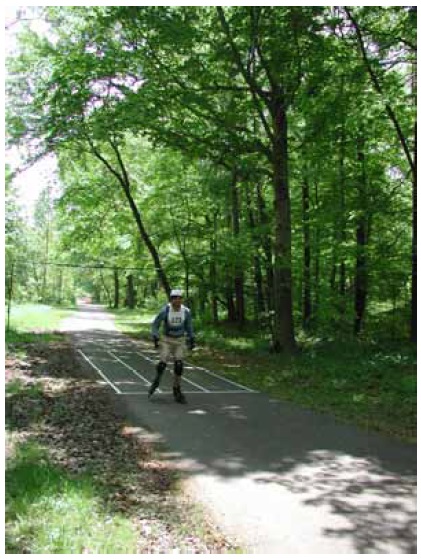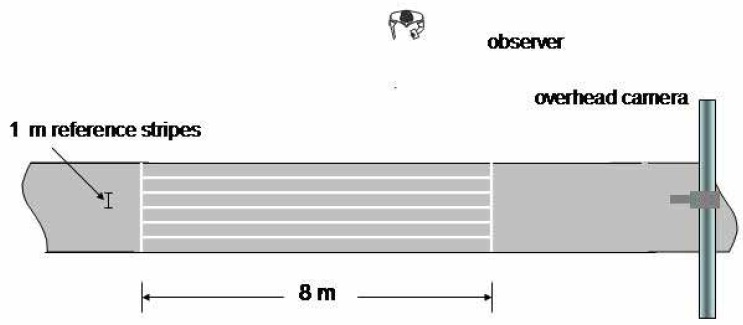Station 5-Lateral Operating Space (Sweep Width)
Space requirements of transportation users are one of the essential inputs in facility design, particularly in determining cross-sectional dimension needs of facilities. The Highway Capacity Manual(26) outlines the levels of service for shared use paths from the perspective of bicyclists, keying on the calculation of passing hindrance,(27) an operational condition affected by relative speed differentials, acceleration rates, and physical space requirements among bicyclists and pedestrians. The proportion of inline skating and other emerging transportation and recreational modes is rapidly increasing on our Nation's shared path facilities. Thus, over time, if the trend continues, the approach of using only bicyclist and pedestrian user groups, as outlined in chapter 11 and 19 of the 2000 Highway Capacity Manual (HCM), to determine a shared use path's level of service (hence design width) may result in under-designed or undersized transportation facilities.
User densities within a transportation facility can often influence the space occupied by the various emerging users (Fruin, as referenced in the HCM 2000). For example, for inline skaters and perhaps scooter operators, as the operating conditions become congested, people's freedom to maneuver becomes constrained and speeds decrease, and the operational space occupied by the user may decrease. Accordingly, researchers focused the survey design, hence data collection, of space dimensions to actual occupied horizontal and vertical dimensions of users operating within uncrowded pathway operating sections of the shared use paths.
Lateral operating space (or "sweep width") is the width needed by the user to operate in a safe manner under normal conditions. In general, this width is much greater than the measured width of the user in a stopped position. This is especially the case for inline skaters. A person who swerves left and right (such as an inline skater) will occupy more lateral space, and have a wider sweep width, than a person whose movements are parallel to the edges of the trail (such as a bicyclist). Both the tread and max values of sweep width were recorded. The tread is the width of the contact(s) with the ground. For example, the tread of a bicycle is the width of its tires. The tread of a wheelchair is the width from the outer edge of the left tire to the outer edge of the right tire. The max includes the width of the user. For example, a young child bicyclist will have a narrower max than an overweight adult bicyclist. The tread and max values also vary with the path that the participants follow while traveling through this station. A person has wider tread and max values if he/she travels diagonally from the left edge to the right edge of the trail than if he/she travels straight down the middle, parallel to the edges of the trail. Determining the lateral operating space of each user group at varying speeds is important for determining appropriate shared use path widths, given knowledge of trail user volumes and application of the level of service methodologies in the Highway Capacity Manual as calibrated in FHWA's recent "Operation of Shared Use Paths" study.
At each event, a section of trail was marked with longitudinal lines (figures 37 and 38). Both active and in situ participants were videotaped as they traveled through this section. The video was subsequently reviewed to determine the tread and max values for each participant.

Figure 37. Sweep widths station.

Figure 38. Sweep width and speed.
26. Transportation Research Board. Highway Capacity Manual 2000. Transportation Research Board, National Academy of Sciences, Washington, DC, 2000.
27. Botma, H. Method to Determine Levels of Service for Bicycle Paths and Pedestrian-Bicycle Paths. Transportation Research Record 743, 1995, pp. 30-37.

User Comments/Questions
Add Comment/Question